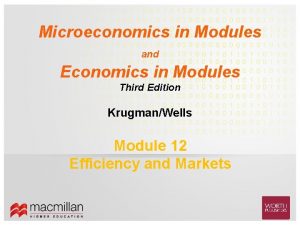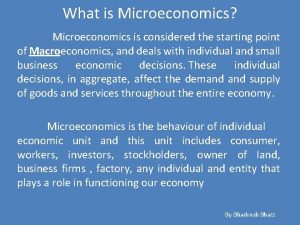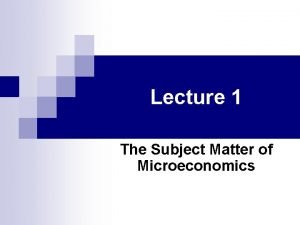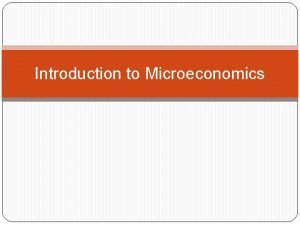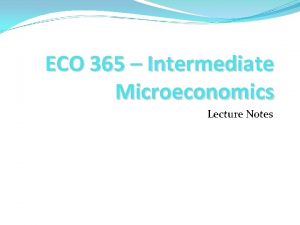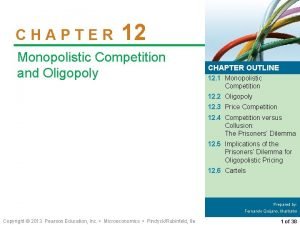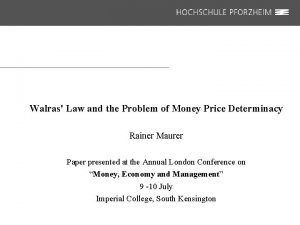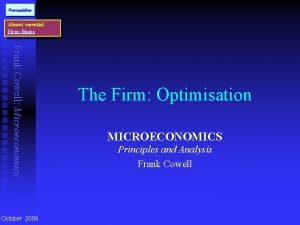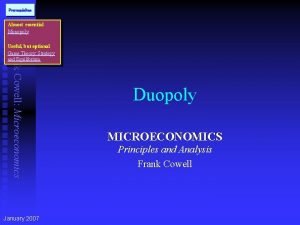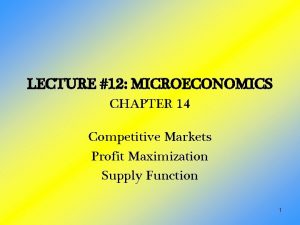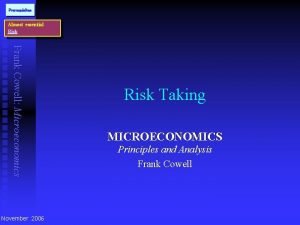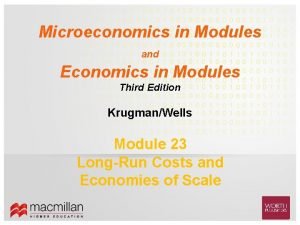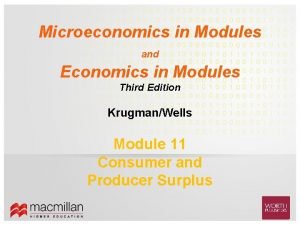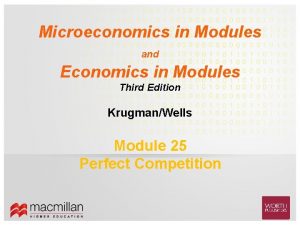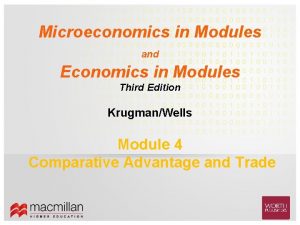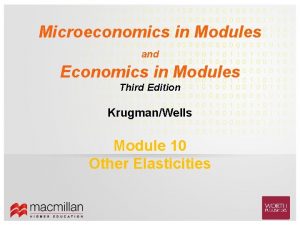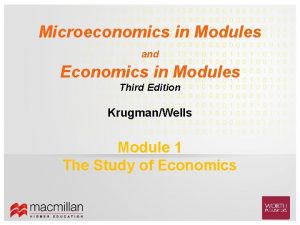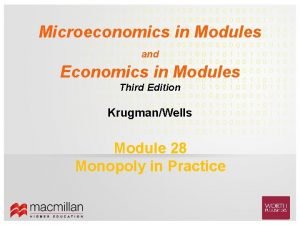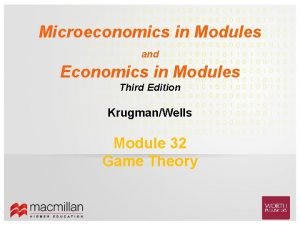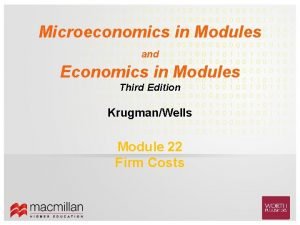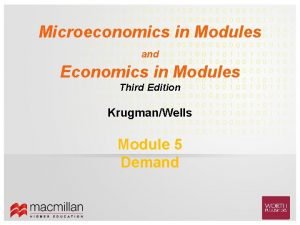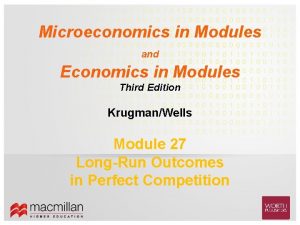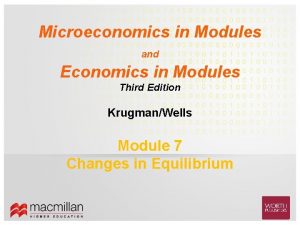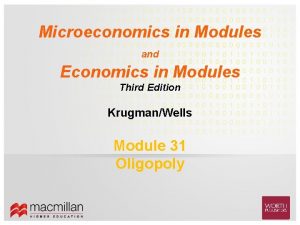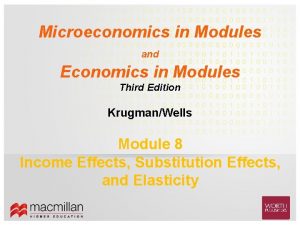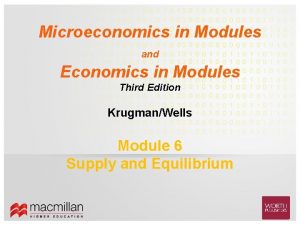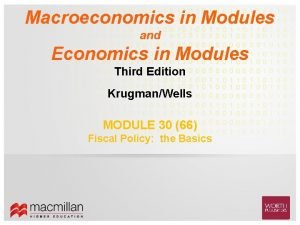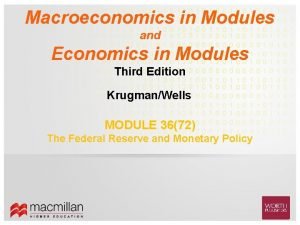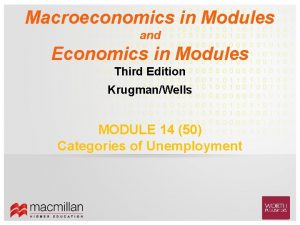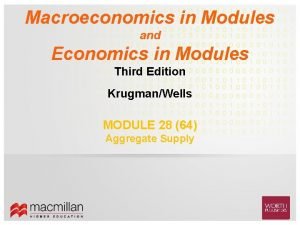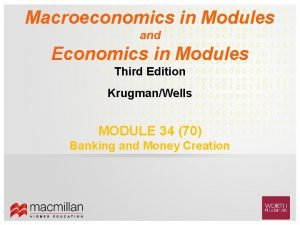Microeconomics in Modules and Economics in Modules Third
























- Slides: 24

Microeconomics in Modules and Economics in Modules Third Edition Krugman/Wells Module 18 Making Decisions

What You Will Learn 1 Why good decision making begins with accurately understanding the costs and the benefits 2 The difference between accounting profit and economic profit and why economic profit is the correct basis for decisions 3 Why there are three types of economic decisions: “either– or” decisions, “how much” decisions, and decisions involving sunk costs 4 The principles of decision making that correspond to each type of economic decision

Explicit versus Implicit Costs • An explicit cost requires an outlay of money. • An implicit cost does not require an outlay of money; it is measured by the value in terms of money of benefits that are forgone.

Opportunity Cost of an Additional Year of School Explicit Cost Tuition Implicit Cost $7, 000 Forgone salary Books and supplies 1, 000 Computer 1, 500 Total explicit cost $9, 500 Total implicit cost Total opportunity cost = Total explicit cost + Total implicit cost = $44, 500 $35, 000

Accounting Profit versus Economic Profit • Accounting profit is equal to revenue minus explicit cost. • Economic profit is equal to revenue minus the opportunity cost of resources used. It is usually less than the accounting profit. • When economists think of profit, they are thinking of economic profit.

Accounting Profit versus Economic Profit Value of increase in lifetime earnings $100, 000 Explicit cost: Tuition Interest paid on student loan Accounting profit – 40, 000 – 4, 000 $56, 000 Implicit cost: Income forgone during two years spent in school Economic profit – 57, 000 – 1, 000

Making “Either–Or” Decisions • When faced with a choice between two activities, choose the one with positive economic profit.

Marginal Cost • The marginal cost of producing a good or service is the additional cost incurred by producing one more unit of that good or service.

Marginal Cost

Marginal Cost • Increasing marginal cost occurs when each unit of a good costs more to produce than the previous unit. • Constant marginal cost occurs when the cost of producing an additional unit is the same as the cost of producing the previous unit. • Decreasing marginal cost occurs when each unit of a good costs less to produce than the previous unit.

Marginal Cost

Marginal Benefit • The marginal benefit of producing a good or service is the additional benefit earned from producing one more unit.

Marginal Benefit • There is decreasing marginal benefit from an activity when each additional unit of the activity yields less benefit that the previous unit.

Marginal Benefit

Marginal Benefit • The marginal benefit of producing a good or service is the additional benefit earned from producing one more unit.

Marginal Benefit

Marginal Analysis • The optimal quantity is the quantity that generates the highest possible total profit.

Marginal Analysis

Marginal Analysis

Marginal Analysis • According to the profit-maximizing principle of marginal analysis, when faced with a profit -maximizing “how much” decision, the optimal quantity is the largest quantity at which the marginal benefit is greater than or equal to marginal cost.

Economics in Action The Cost of a Life • It is tempting to say that a human life is infinitely precious. • Resources are scarce and we cannot spend infinite amounts, so we must decide how much to spend on saving lives.

Sunk Costs • A sunk cost is an irretrievable cost that has already been incurred. • Sunk costs should be ignored in making decisions about future actions because they have no influence on their actual costs and benefits.

Summary 1. An explicit cost requires an outlay of money. 2. An implicit cost does not require an outlay of money. 3. Accounting profit is equal to revenue minus explicit cost. 4. Economic profit is equal to revenue minus the opportunity cost of resources used. 5. According to the principle of “either–or” decision making, when facing a choice between two activities, one should choose the one with the positive economic profit.

Key Terms 6. Marginal analysis is used to make “how much” decisions. 7. The marginal cost of producing a good or service is the additional cost incurred by producing one more unit of that good or service. 8. The marginal benefit of producing a good or service is the additional benefit earned from producing one more unit. 9. The optimal quantity is the quantity that generates the highest possible total profit.
 Economics modules
Economics modules Cavity classification
Cavity classification Mounts classification
Mounts classification School of business and economics maastricht
School of business and economics maastricht Principles of economics third edition pdf
Principles of economics third edition pdf Externalities and public goods microeconomics
Externalities and public goods microeconomics Micro macro
Micro macro Macroeconomics? - definition and examples
Macroeconomics? - definition and examples Econ213
Econ213 Copy
Copy What is the subject matter of microeconomics
What is the subject matter of microeconomics Significance of microeconomics
Significance of microeconomics Intermediate microeconomics lecture notes
Intermediate microeconomics lecture notes Intermediate microeconomics notes
Intermediate microeconomics notes Cartel microeconomics
Cartel microeconomics Loi de walras
Loi de walras Almost essential
Almost essential Microeconomics michael parkin 13th edition
Microeconomics michael parkin 13th edition Objectives of microeconomics
Objectives of microeconomics Almost essential
Almost essential Microeconomics
Microeconomics Uses of microeconomics
Uses of microeconomics Branches of economics
Branches of economics Microeconomics chapter 12
Microeconomics chapter 12 Cowell microeconomics
Cowell microeconomics
